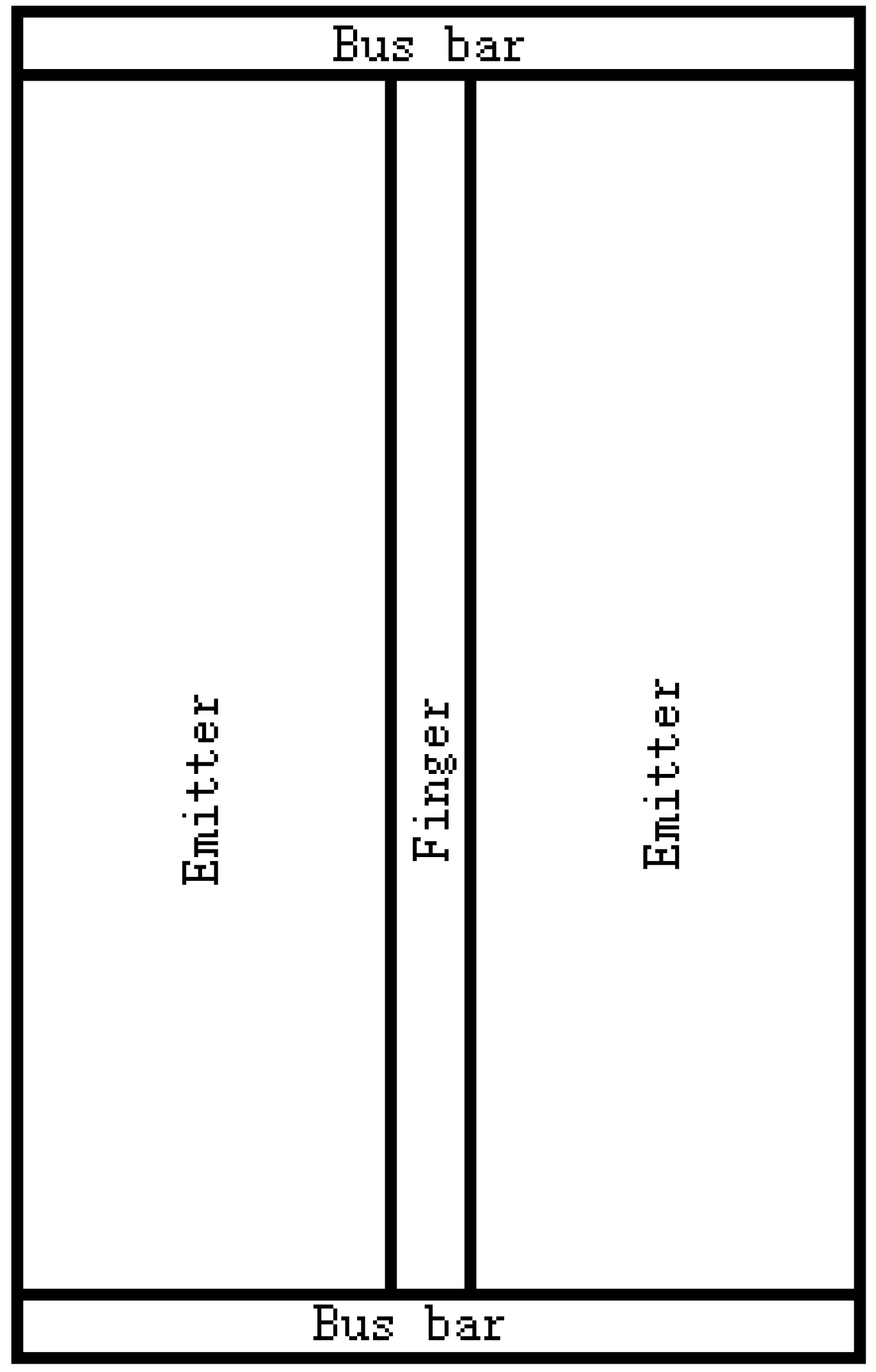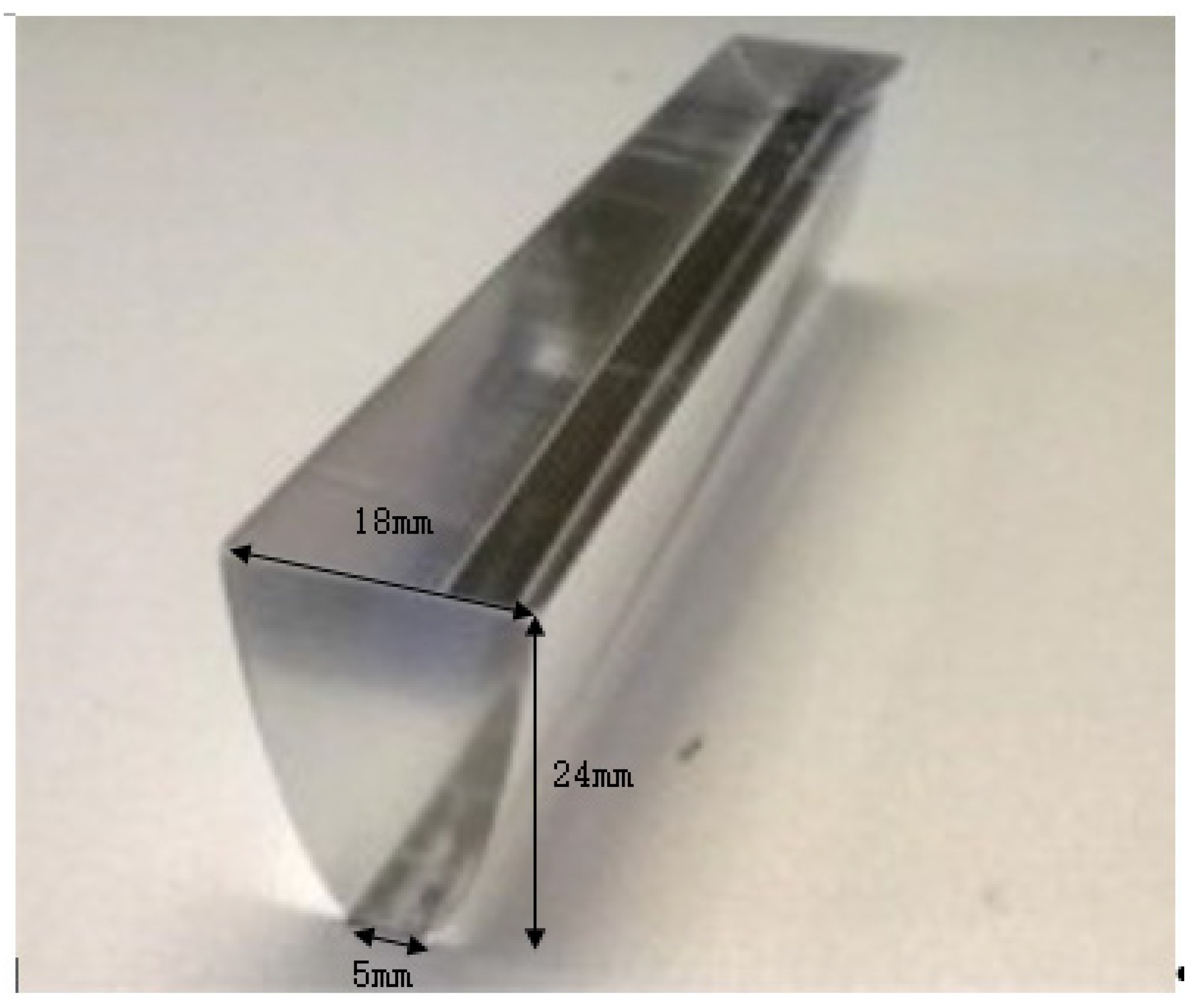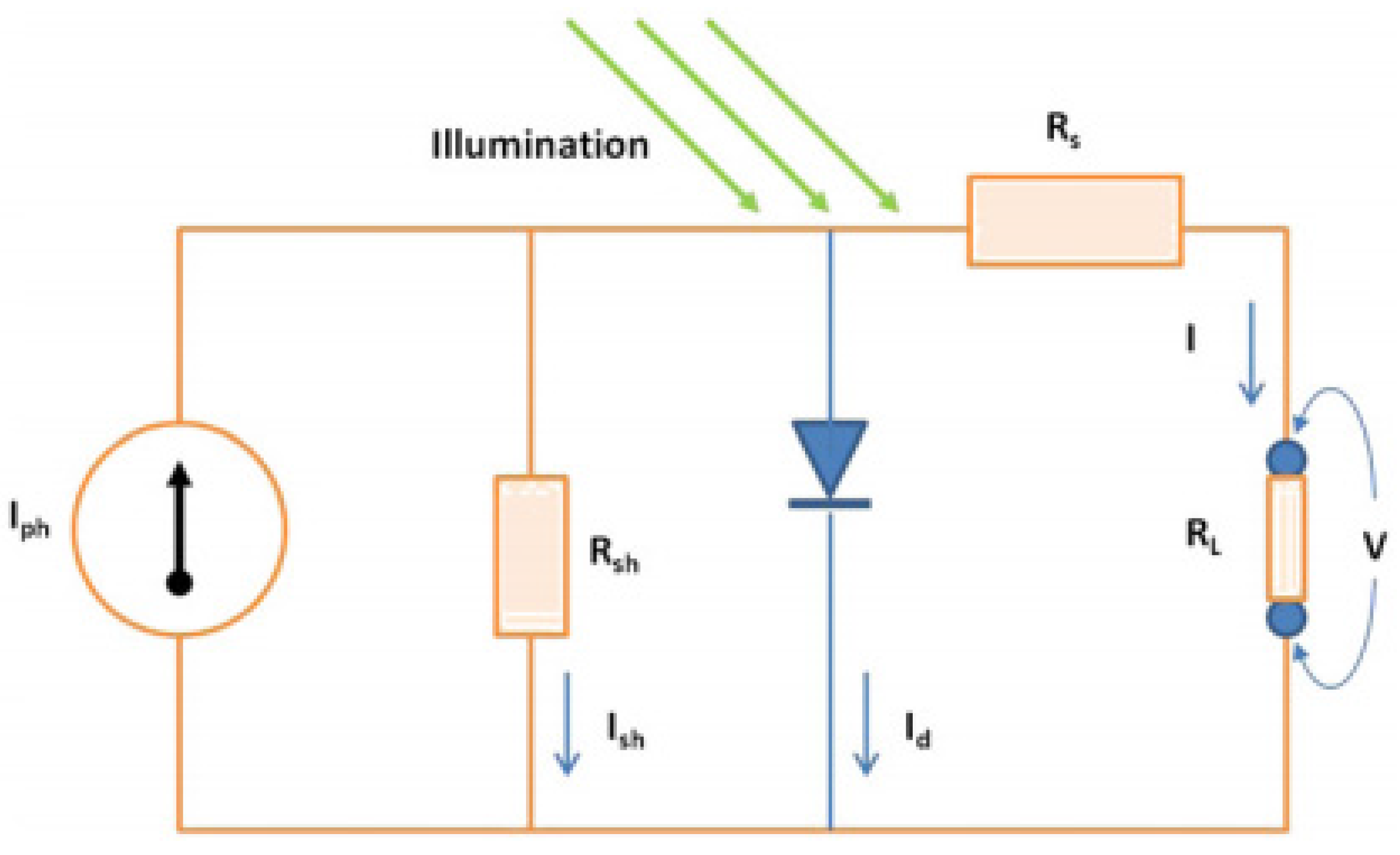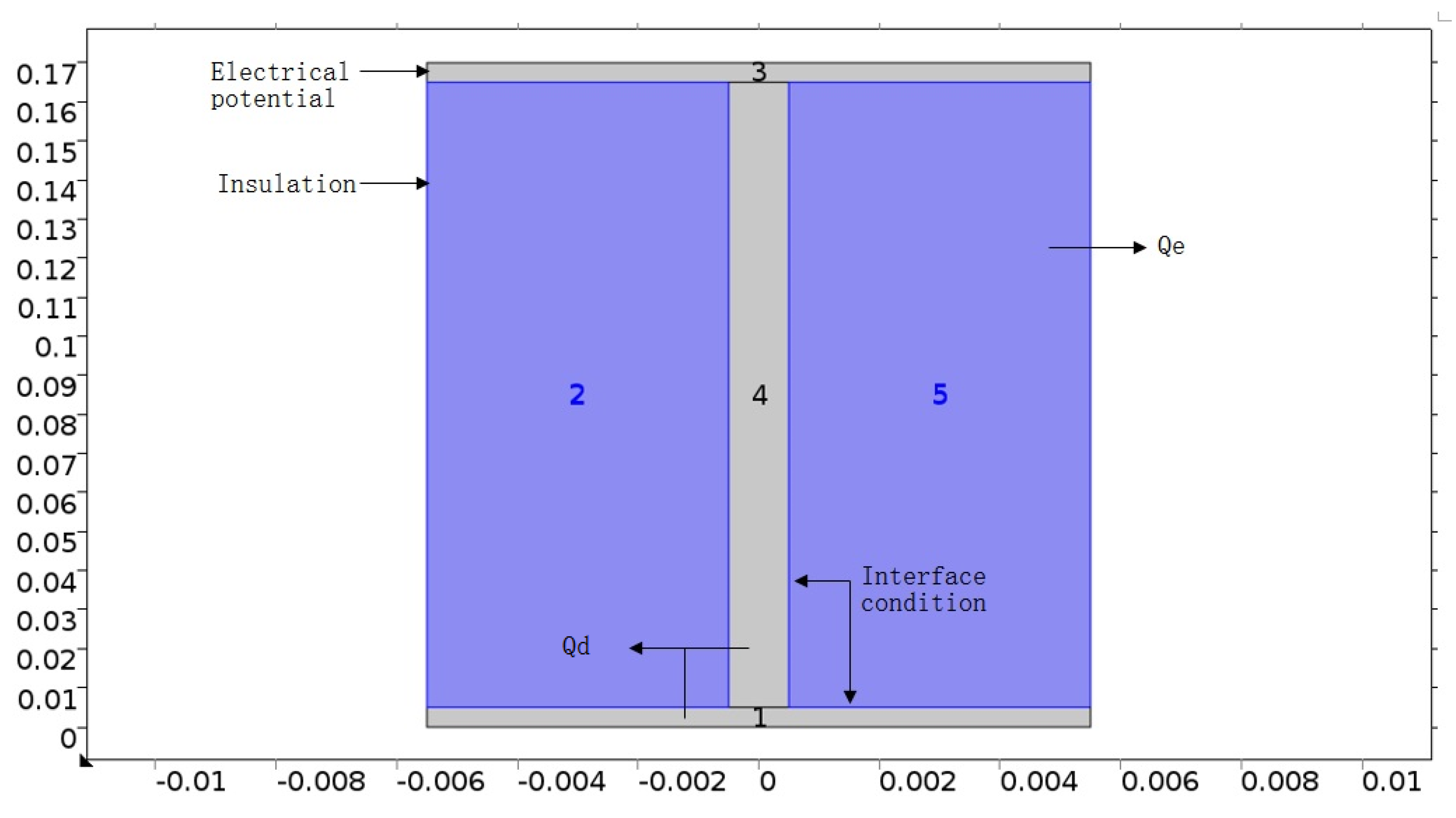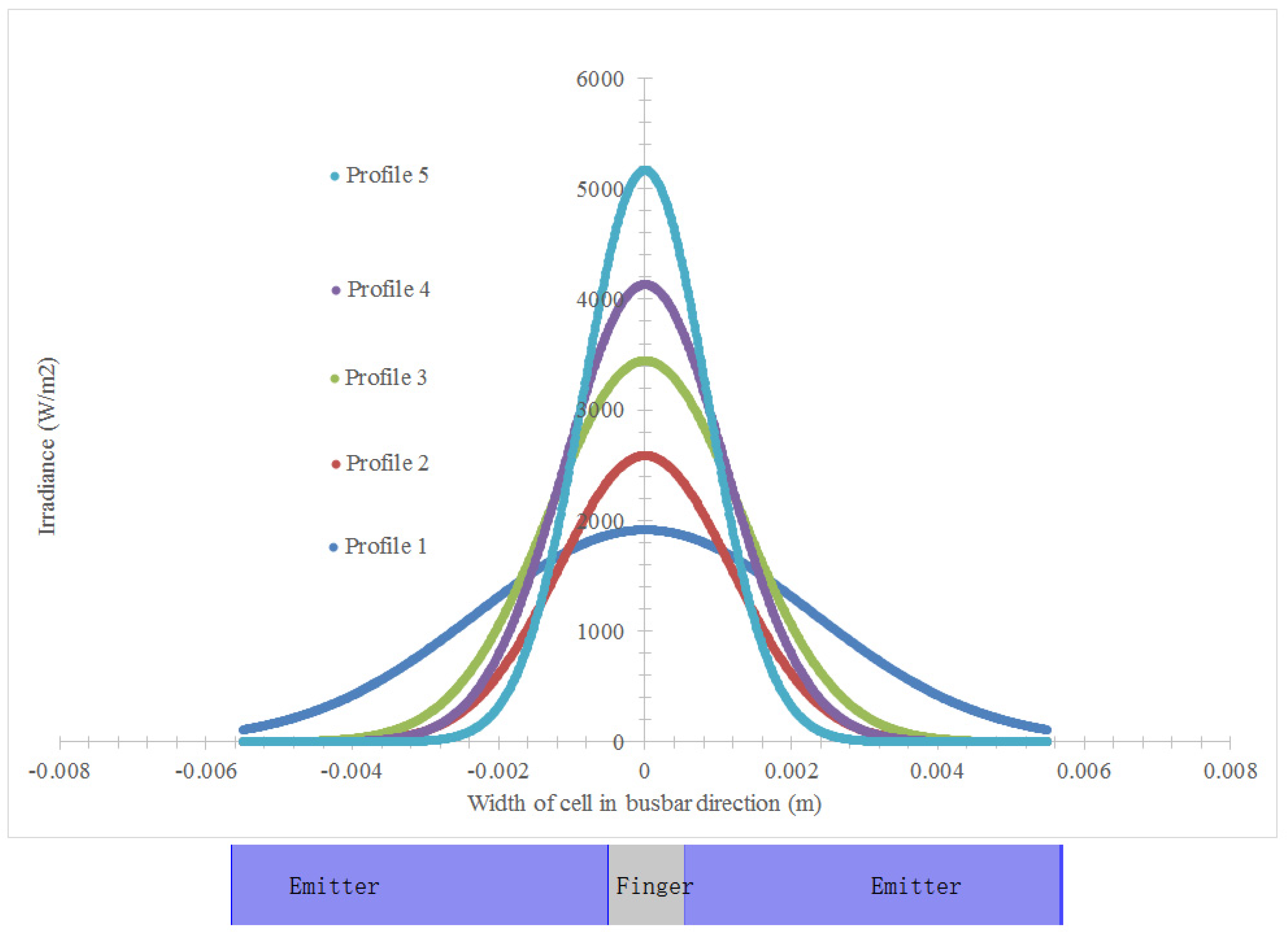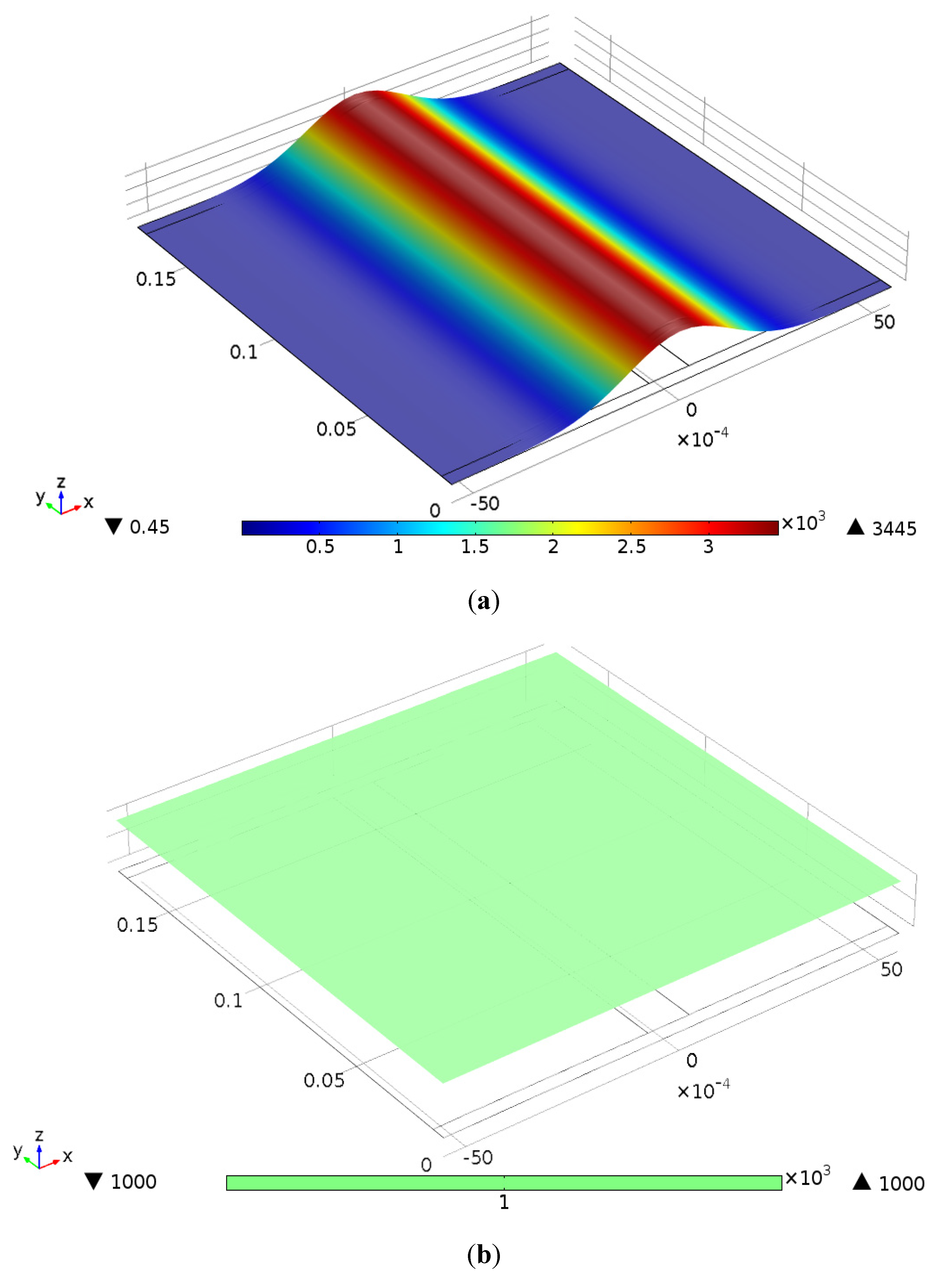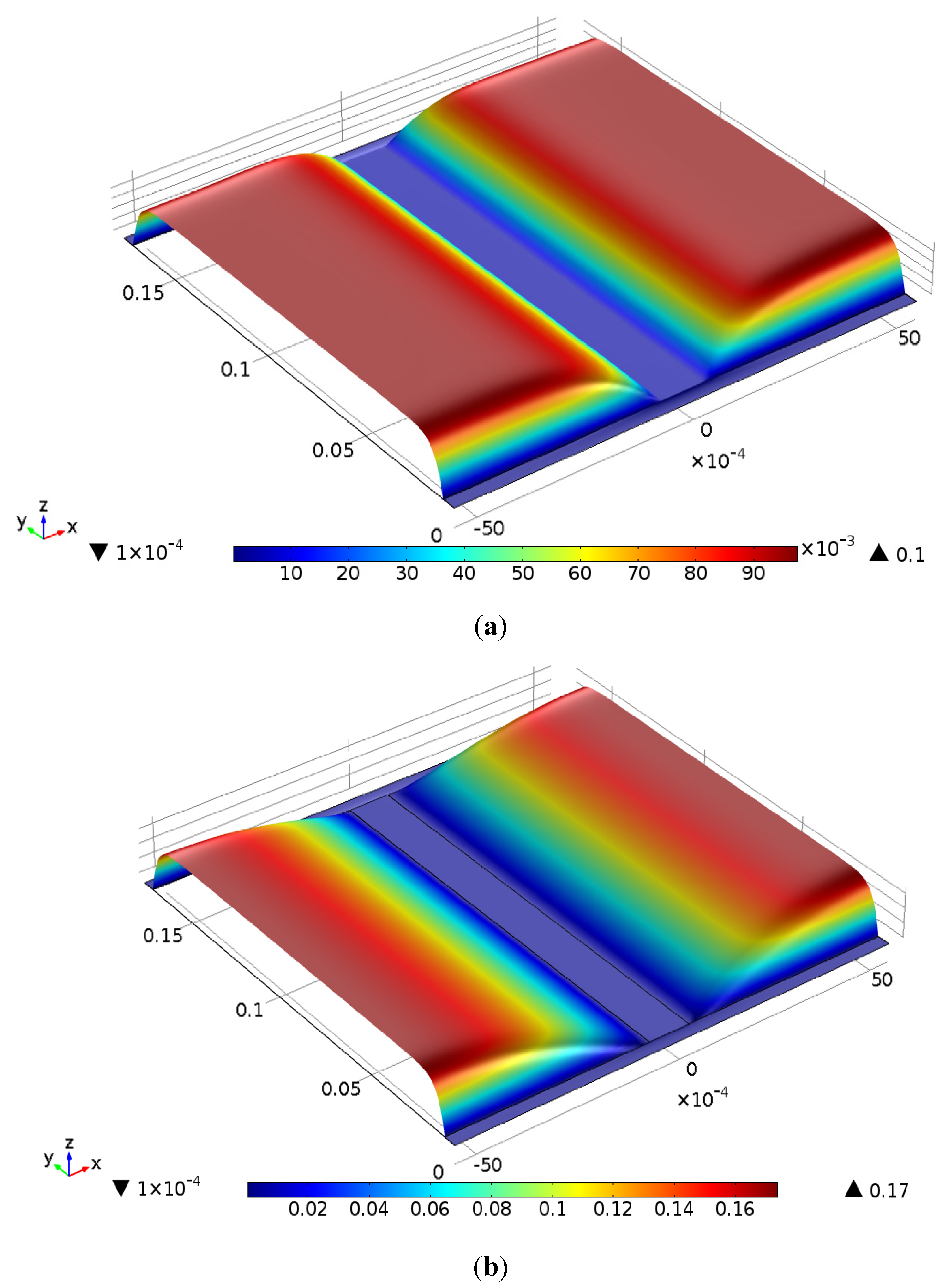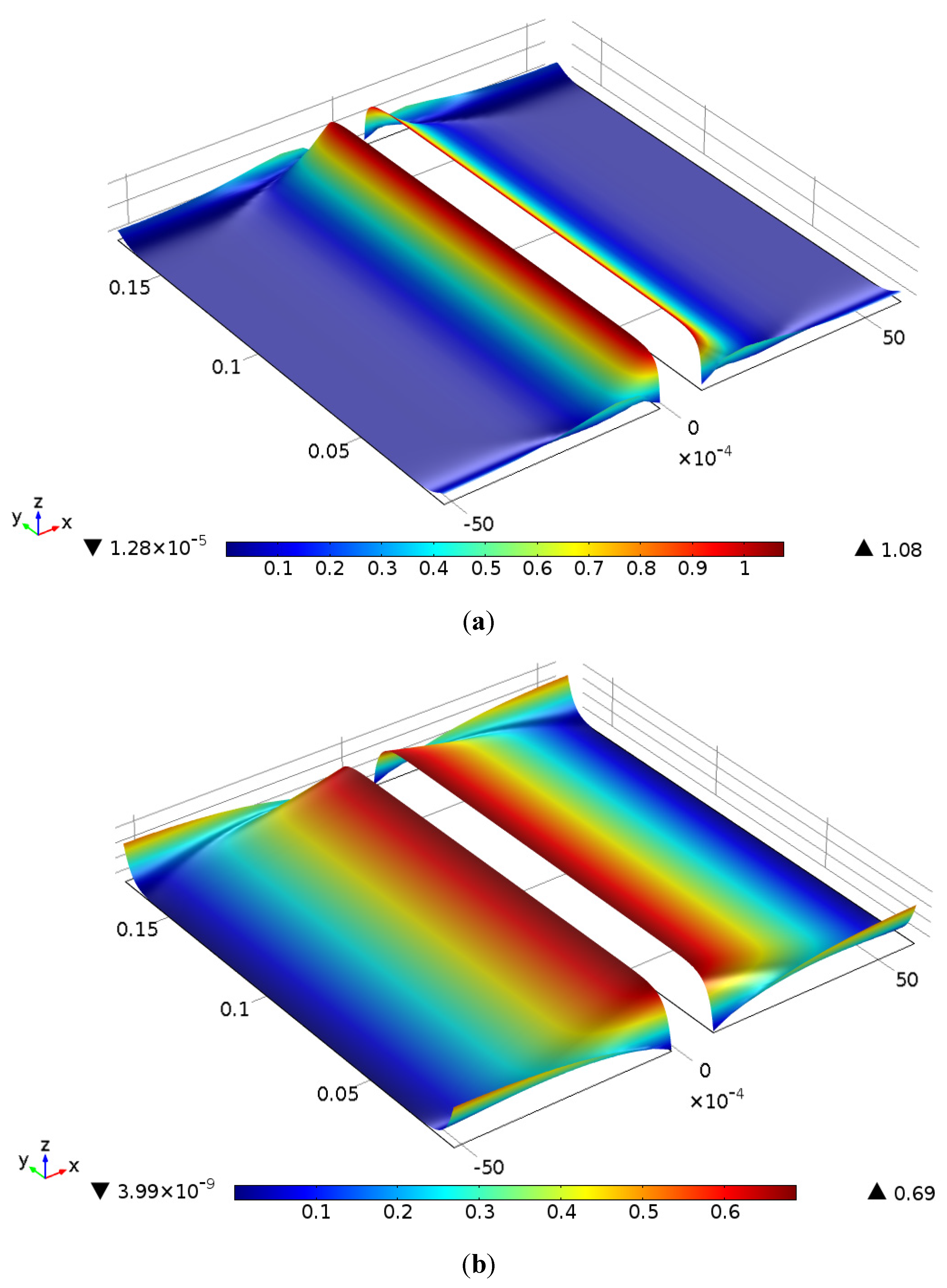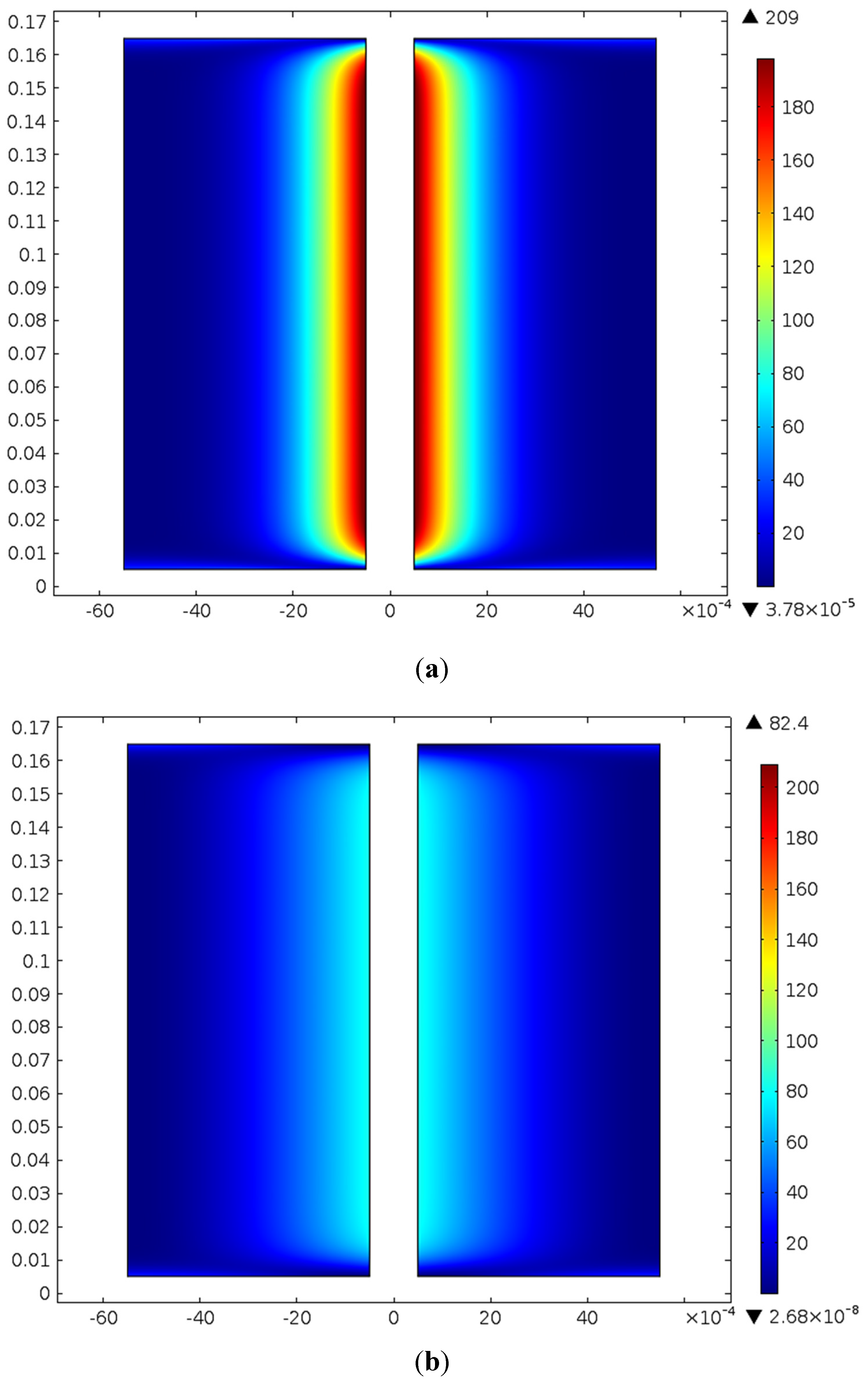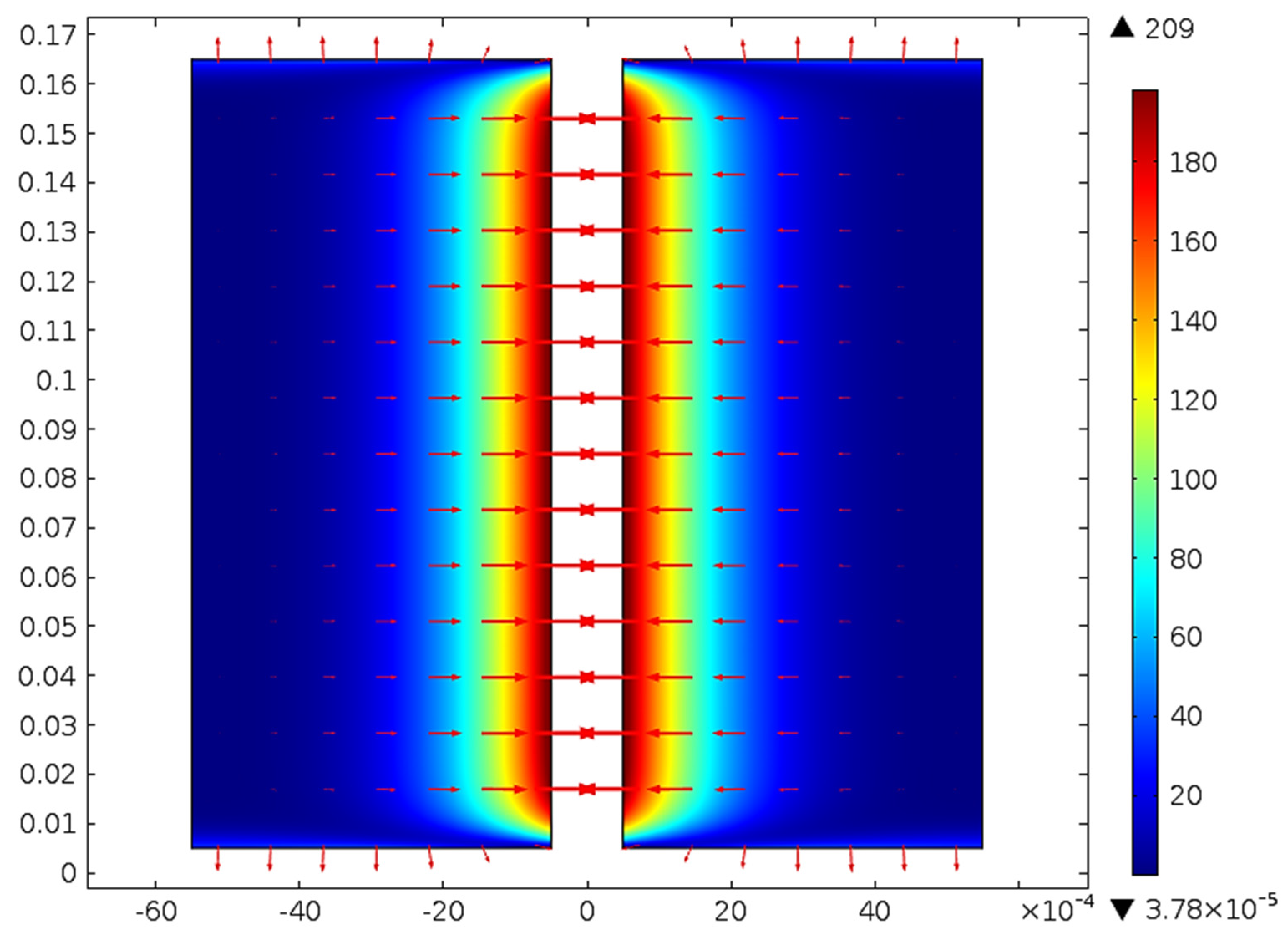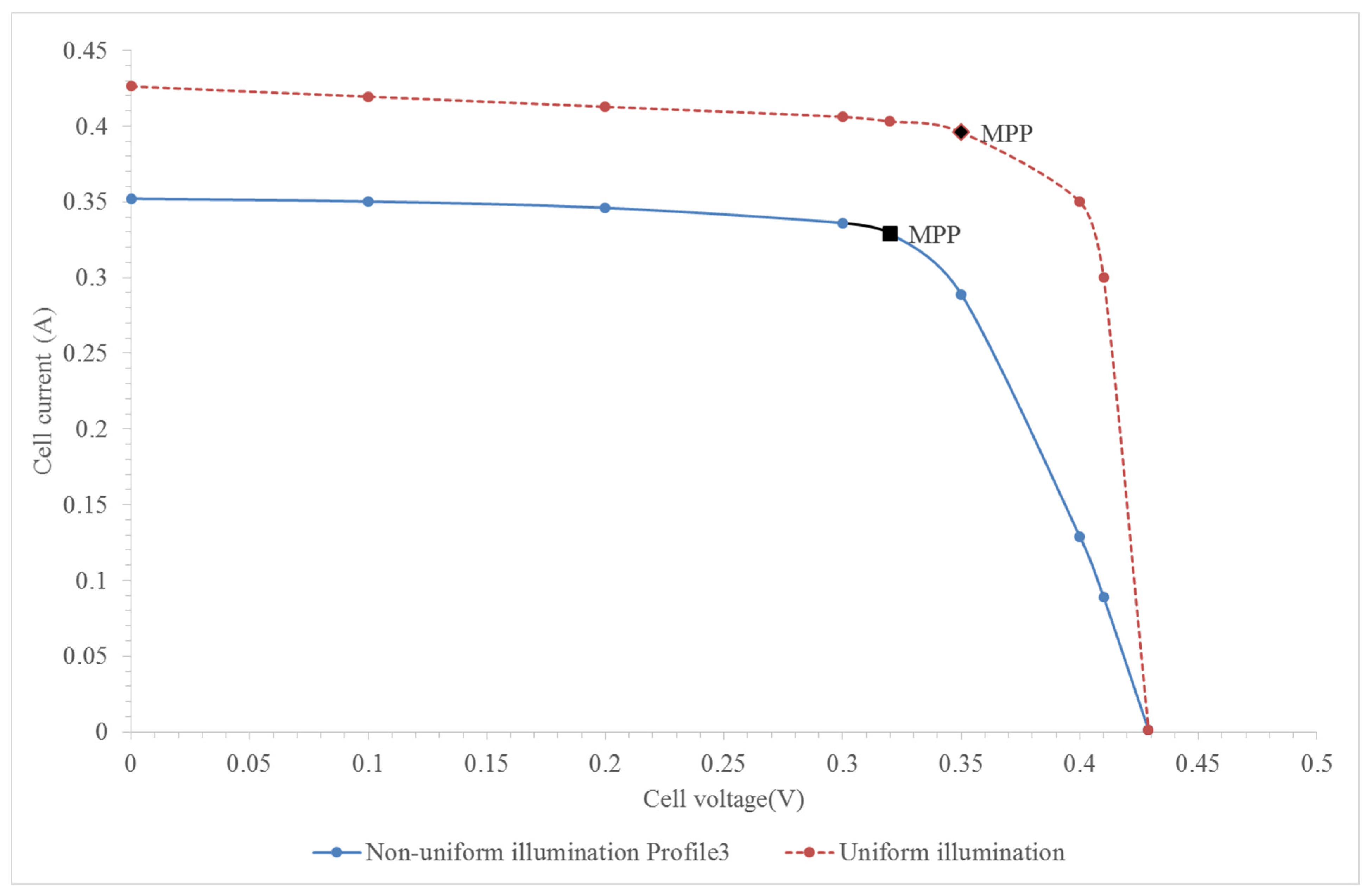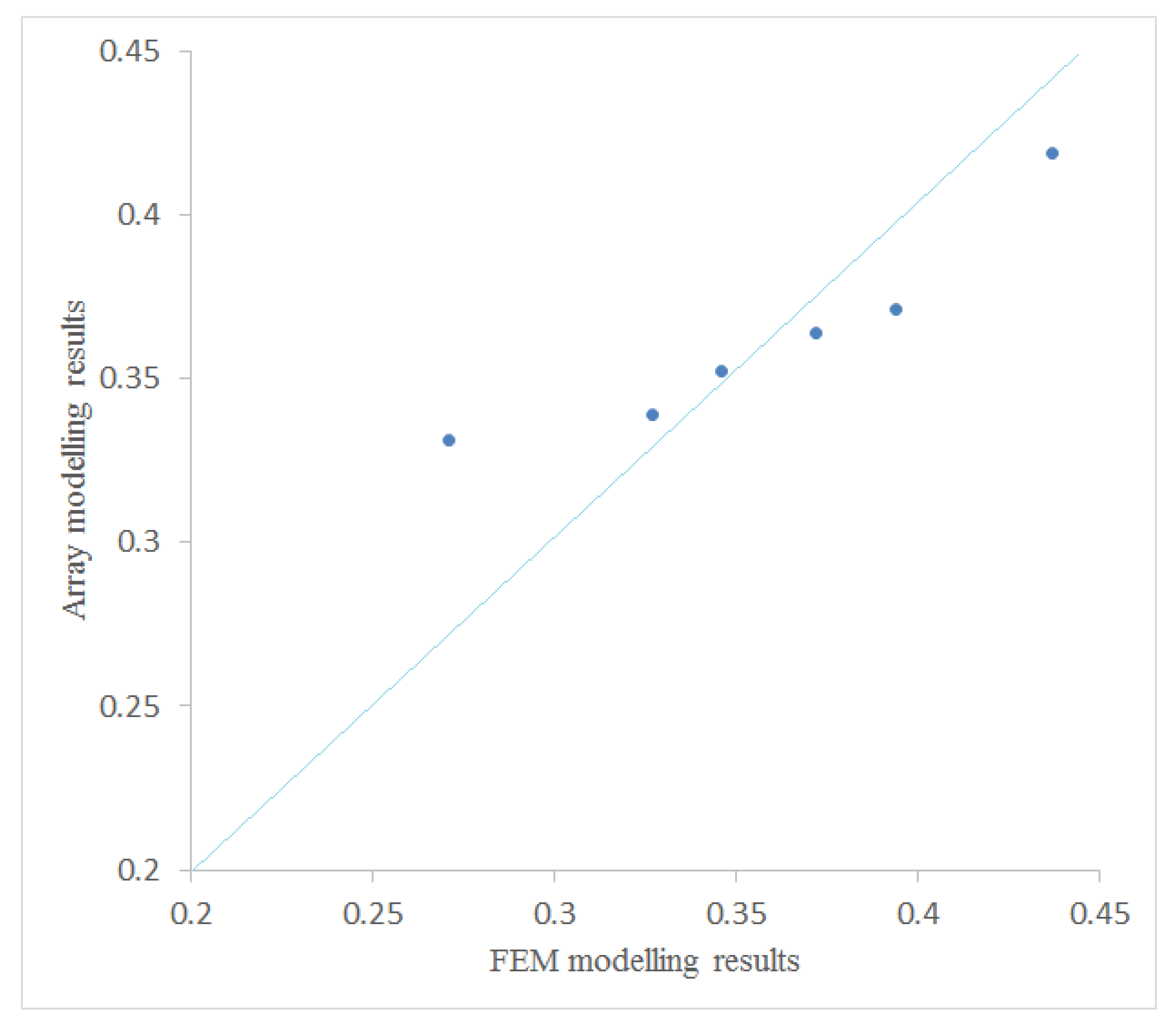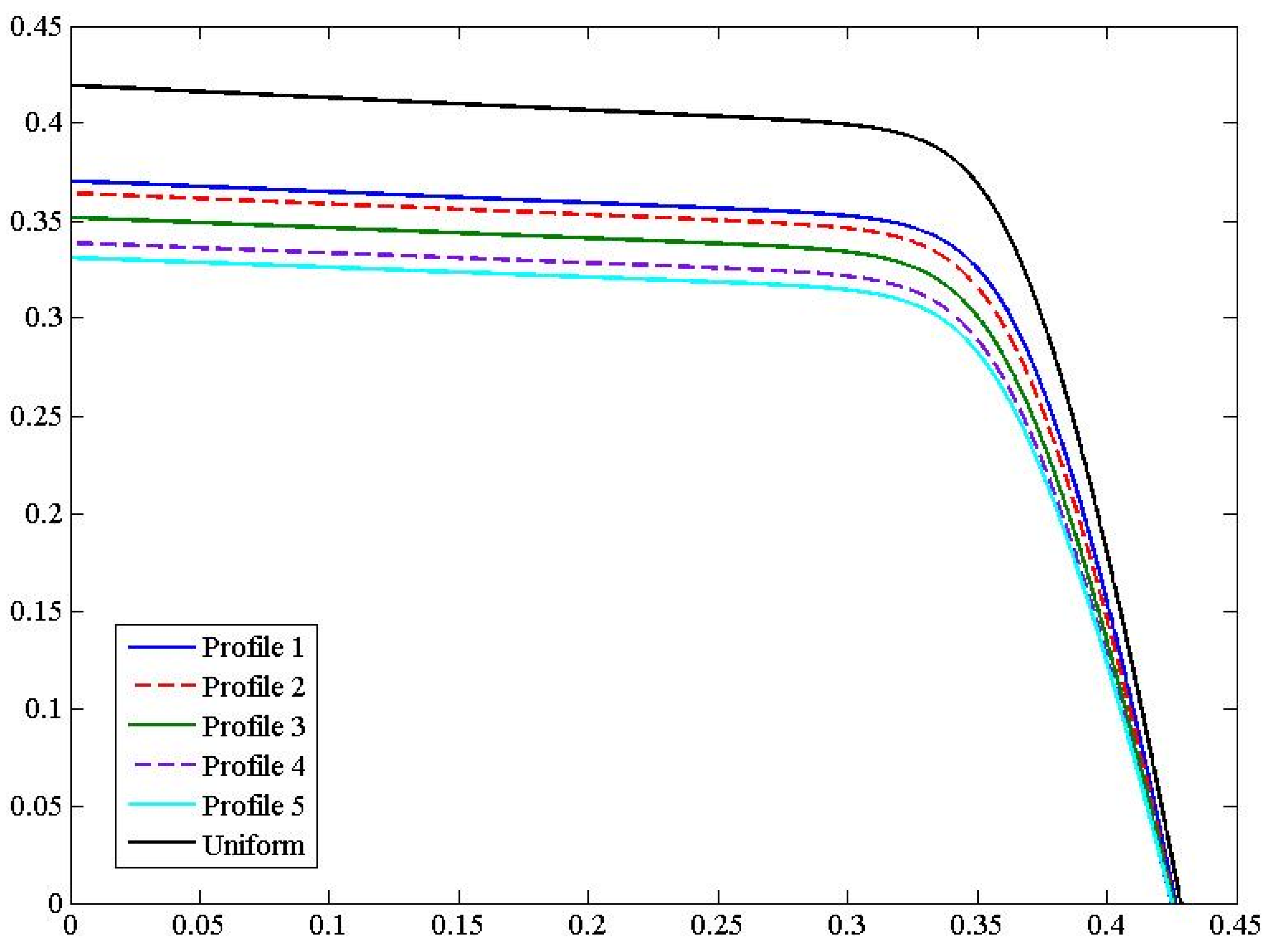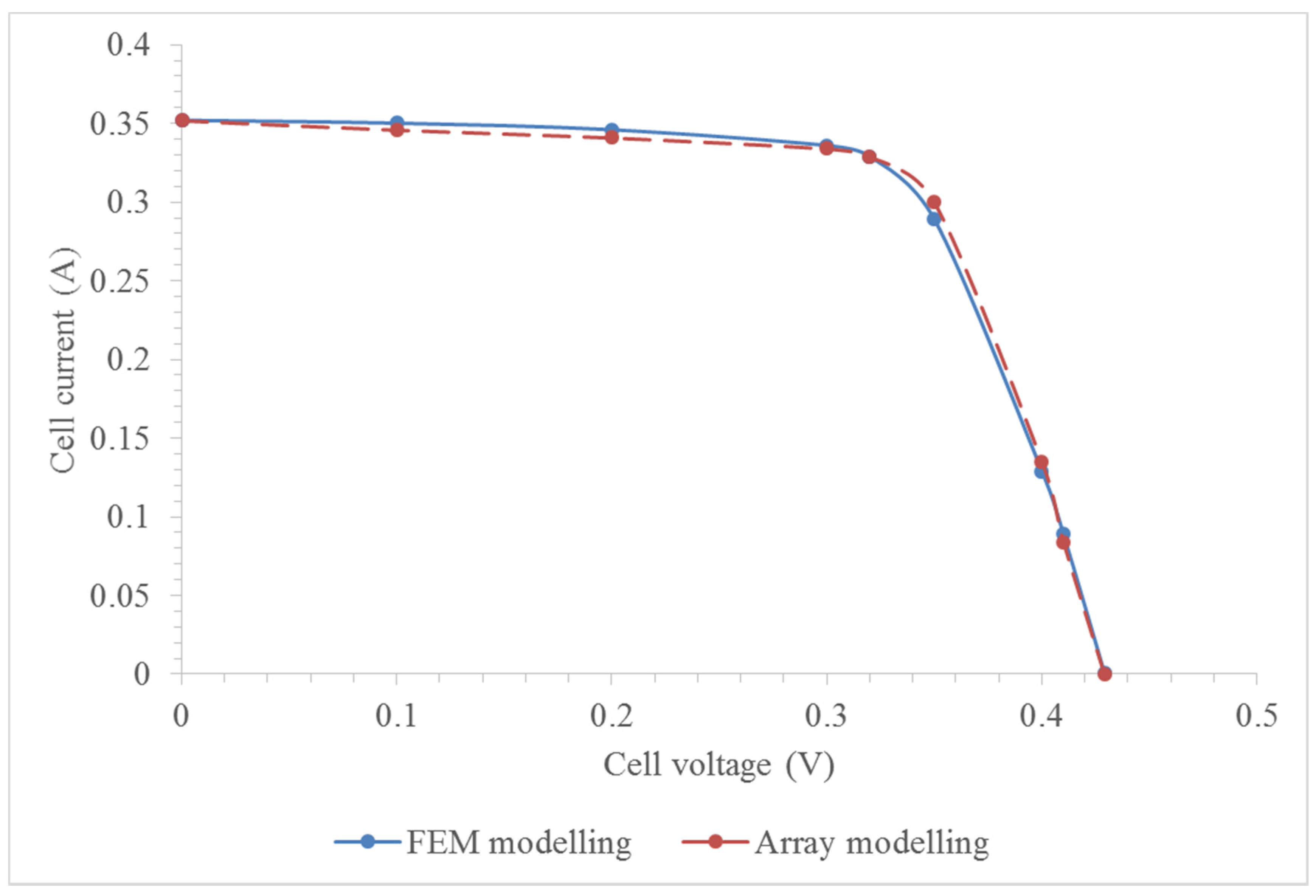3.2. Simulation Results for Comparison of Two Illumination Profiles
In this section, the FEM model uses Profile 3 in the simulation to investigate cell performance under non-uniform illumination conditions and compare them with uniform illumination conditions. The simulated illumination profiles are plotted in
Figure 6. The Gaussian distribution illumination is distributed evenly along the cell longitudinal direction. The average illumination intensity per surface area is the same for both cases.
The voltage drop through the cell could be explained as a “distributed diode effect”, which could be summarized as follows: the lateral resistances in the cell lead to a voltage drop across the cell surface, causing different points on the cell surface to operate at different voltages and therefore produce different current densities, as explained by Franklin
et al. [
17]. The voltage distributions for both case are plotted in
Figure 7. Under concentrated light conditions, the diode effect is significant since current densities could have large differences from the middle area towards to the edges and the resulting voltage drops are high.
Figure 6.
Simulated illumination distribution for: (a) Profile 3; (b) Uniform illumination distribution, x-axis is the busbar direction (m) and y-axis is the finger direction (m).
Figure 6.
Simulated illumination distribution for: (a) Profile 3; (b) Uniform illumination distribution, x-axis is the busbar direction (m) and y-axis is the finger direction (m).
Figure 7.
PV cell surface voltage distribution under the short circuit condition for: (a) Profile 3; (b) uniform illumination distribution, x-axis is the bus bar direction (m) and y-axis is the finger direction (m).
Figure 7.
PV cell surface voltage distribution under the short circuit condition for: (a) Profile 3; (b) uniform illumination distribution, x-axis is the bus bar direction (m) and y-axis is the finger direction (m).
The cell surface current density distributions subjected to both conditions are given in
Figure 8. The high conductivity of the finger region will cause the generated current in emitter regions to be quickly absorbed and passed to the bus-bars. The high illumination area on the cell causes non-uniform current generation along the cell, which results in a sharping change of current density along the cell surface.
Figure 8.
PV cell surface current density distribution under the short circuit condition for: (a) Profile 3; (b) uniform illumination distribution, x-axis is the bus-bar direction (m) and y-axis is the finger direction (m).
Figure 8.
PV cell surface current density distribution under the short circuit condition for: (a) Profile 3; (b) uniform illumination distribution, x-axis is the bus-bar direction (m) and y-axis is the finger direction (m).
The biggest influence of non-uniform illumination is on the cell resistive losses. Both the position and intensity of the light play an important role to determine the resistive losses.
Figure 9 shows a clear increase of resistive losses in the highly illuminated regions in comparison with uniform illumination conditions. This increase of resistive losses could be expressed in more detail by
Figure 10, where the arrows indicate the direction and strength of the current. In the highly illuminated area, the generated photocurrent is absorbed by the finger region and then travels to the bus-bar, whereas, in the areas with less illumination, the generated current enters from the bus-bar and flows to the finger. The high non-uniformity makes the electrons to travel further through the finger to the bus-bars and causes the losses. A similar phenomenon is also mentioned in other works, such as Franklin
et al. [
17].
Figure 9.
PV cell surface resistive losses distribution under the short circuit condition for: (a) Profile 3 (b) uniform illumination distribution, x-axis is the bus-bar direction (m) and y-axis is the finger direction (m).
Figure 9.
PV cell surface resistive losses distribution under the short circuit condition for: (a) Profile 3 (b) uniform illumination distribution, x-axis is the bus-bar direction (m) and y-axis is the finger direction (m).
Figure 10.
PV cell surface resistive losses distribution and vector of current for Profile 3 under the short circuit condition, x-axis is the bus-bar direction (m) and y-axis is the finger direction (m).
Figure 10.
PV cell surface resistive losses distribution and vector of current for Profile 3 under the short circuit condition, x-axis is the bus-bar direction (m) and y-axis is the finger direction (m).
Usually an I-V curve is used to demonstrate the performance of the PV cell and can be generated by the superposition of the cell diode I-V curve in the dark with light-generated current. For a given boundary voltage, the current of a PV cell can be obtained from the FEM results, and the plot I-V curves can be then given.
Figure 11 shows the simulation results of PV cell performance under both uniform light and non-uniform light conditions. In this simulation, the cell operating temperature is considered as a constant. Since the voltages are mostly influenced by varying temperature, the voltages in both saturations are constant. The high resistive losses introduced by non-uniform illumination cause the maximum current to drop significantly. The maximum power point would also shift from this influence, which gives about a 20% drop in the cell efficiency. It may be necessary to mention that this drop also includes the effect of finger shading, which is discussed in the following section.
3.3. Comparison between FEM and Array Modelling
The array modelling is a different approach to investigate PV cell performance under non-uniform illumination. It simply considers the cell to be equivalent to a parallel-connected array of numerous small cell splits, where each split has its own input parameters according to the illumination profile. The final output is the combination from each split. The array modelling is implemented on the MATLAB platform and built mostly on the mathematical expressions. However, the FEM has more features to analyze the physical properties of PV cell, while the array modeling is a fast approach to produce I-V curves because it is based on algebraic calculations. The aim is to compare both approaches in order to investigate a more efficient way to simulate PV cell under non-uniform illumination condition. The detail about the array modelling can be found in our previous study [
14].
Figure 11.
I-V curves for uniform illumination and illumination Profile 3.
Figure 11.
I-V curves for uniform illumination and illumination Profile 3.
The illumination profiles simulated in the array modelling were given according to the distributions in
Figure 5 and listed in
Table 6, in order to characterize the results obtained from both approaches. The cell is assumed to be split evenly into 10 stripes to give 0.001 m (1 mm) width each cell split. For the y-axis direction in
Figure 4, the illumination is assumed to be uniform. The average irradiance value was calculated according to the distribution along the x-axis over the 0.001 m width for each cell split. However, as the non-uniformity increases, more light is concentrated in the middle region and sharply drops towards the edges along the x-axis direction in
Figure 4. For all of the illumination profiles, a significant portion of light is shaded by the finger, therefore the shading from the finger needs to be considered in the array modelling. The finger width is 0.001 m, which means half of Split 5 and Split 6 are shaded. Therefore, the range of the illumination distribution to estimate the irradiance value is from −0.001 to −0.0005 for Split 5 and from 0.0005 to 0.001 for Split 6. The reason for this adjustment is because the array modelling is not related to the structure of a cell, but just the overall performance of a cell. To count the effect of the width of the finger in the array modelling and have a fair comparison with the FEM approach, the above adjustment was therefore made to each illumination profile including uniform distribution.
The high non-uniformity introduces more resistive losses and causes the decrease of the maximum current output. The simulation results for short-circuit current were obtained from two modelling approaches and listed in
Table 7. The results from both platforms show a good agreement, as can be seen from
Figure 12. The relative deviations are mostly within ±10%, however it becomes larger when the non-uniformity of illumination is bigger.
Table 6.
Irradiance values for ten cell splits in the array modelling (W/m2).
Table 6.
Irradiance values for ten cell splits in the array modelling (W/m2).
| Profile | Split 1 | Split 2 | Split 3 | Split 4 | Split 5 | Split 6 | Split 7 | Split 8 | Split 9 | Split 10 | Average |
|---|
| Uniform | 1000 | 1000 | 1000 | 1000 | 500 | 500 | 1000 | 1000 | 1000 | 1000 | 900 |
| Profile 1 | 374 | 577 | 980 | 1406 | 902 | 902 | 1406 | 980 | 577 | 374 | 848 |
| Profile 2 | 92 | 352 | 891 | 1676 | 1161 | 1161 | 1676 | 891 | 352 | 92 | 834 |
| Profile 3 | 1 | 105 | 688 | 1800 | 1440 | 1440 | 1800 | 688 | 105 | 1 | 807 |
| Profile 4 | 1 | 50 | 450 | 1765 | 1620 | 1620 | 1765 | 450 | 50 | 11 | 777 |
| Profile 5 | 1 | 11 | 141 | 1321 | 1730 | 1730 | 1321 | 1341 | 1 | 1 | 760 |
Table 7.
Simulation results of short-circuit current in two modelling approaches.
Table 7.
Simulation results of short-circuit current in two modelling approaches.
| Profile | Finite element modelling (A) | Array modelling (A) | Relative deviation (%) |
|---|
| Uniform | 0.437 | 0.419 | −4 |
| Profile 1 | 0.394 | 0.371 | −6 |
| Profile 2 | 0.372 | 0.364 | −2 |
| Profile 3 | 0.346 | 0.352 | 2 |
| Profile 4 | 0.327 | 0.339 | 4 |
| Profile 5 | 0.271 | 0.331 | 18 |
Figure 12.
Simulation results from two modelling approaches.
Figure 12.
Simulation results from two modelling approaches.
The I-V curves for each illumination profile in the array modelling are plotted in
Figure 13. From Profiles 1 to 5, it can see the drop in short-circuit current as well as shifting of the maximum power point. Besides the influence from non-uniform illumination, the cell efficiency could also be affected by the finger design. This indicates the importance of finger design and positioning.
Figure 14 gives the I-V curves and maximum power points for illumination Profile 3 for both approaches, and indicates a good agreement between them. In the FEM approach, the geometry design can be easily changed according to the requirements, so it can offer an appropriate way for designing and positioning fingers, while the array modelling approach may represent a fast way to investigate the effect of non-uniform illumination, for example, by plotting I-V curves.
Figure 13.
I-V curves given by the MATLAB array modelling for several illumination profiles.
Figure 13.
I-V curves given by the MATLAB array modelling for several illumination profiles.
Figure 14.
I-V curves given by array modelling and FEM modelling for illumination Profile 3.
Figure 14.
I-V curves given by array modelling and FEM modelling for illumination Profile 3.
